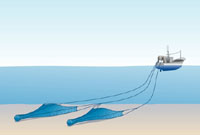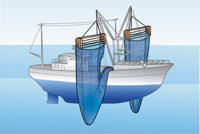Sustain • Good Catch • Start improving • Step 1 - Gather information
Demersal trawling
 Otter (single), twin-rig and pair trawlers
Otter (single), twin-rig and pair trawlers
In demersal trawl fisheries, a funnel-shaped net is towed behind either one (single trawl) or two (pair–trawl) boats. Once the net has been towed it is drawn out of the water to collect the captured fish. Twin-rig trawls follow the same principle but tow two nets. These demersal trawling methods fish along or just above the seafloor catching bottom dwelling fish.
Beam trawlers
Beam trawls target fish on the seabed. They tow a net from either side of the boat. The mouth of the net is weighted and kept open by a metal beam that can be up to 12m long. Metal ‘tickler chains’ are attached to the gear to disturb fish from under the surface of the seabed and into the trawl.
Seine netting
Seine netters use a net that is vertical in the water, with very long ropes attached leading back to the vessel. These drag on the ground, setting up a sand or mud cloud, which herds fish into the net.
Examples of target species
- Otter and pair-trawls – cod, haddock, whiting and flatfish.
- Twin-rig trawl – langoustine and prawns.
- Beam trawl – flatfish, such as plaice and sole.
- Seine netting – cod, haddock, whiting.
Environmental summary
- Habitat damage - damage and disturbance to the seabed and bottom living marine animals occurs as the fishing gear comes into contact with the ocean floor. Sensitive habitats, such as corals, are more susceptible to long-term damage than areas of sand and mud, which tend to be less severely impacted. The heavy gear dragged by beam trawlers is particularly notable in habitat damage.
- Bycatch of vulnerable species - demersal trawls may unintentionally catch vulnerable species such as skates which, like trawl target species, are demersal.
- Discards - bottom living fish often congregate in mixed species groups so trawling for a particular species can be associated with bycatch of non-target fish and other marine life. The accidental catch and discarding of juvenile commercial fish species can impact on these populations. In general trawls are associated with higher levels of bycatch compared to other fishing methods.
Mitigation
Efforts to reduce environmental damage include larger mesh sizes which in theory allow juvenile or non-targeted fish to escape. Redesigned nets help to reduce bycatch and the use of lighter materials in net construction have helped lessen the damage to the seabed and reduce fuel consumption. The use of rubber discs on the front edge of nets can reduce seabed damage and fish bycatch. These efforts have been successful to varying degrees.
In beam trawls new techniques being trialled include an electronic pulse in place of ‘tickler chains’, in order to disturb fish into the net while mitigating damage to the seabed. Plus initiatives, such as Project 50% in the south west, are working to reduce wasteful discards by improving fishing gear. Seine netting is operated slowly and for a short time, meaning faster swimming species like coley and pollack can escape.
Good Catch: Good Catch provides practical information for chefs, caterers and restaurateurs, making it easier for them to serve more sustainable seafood.

